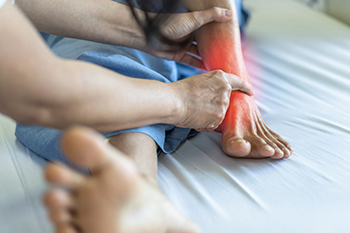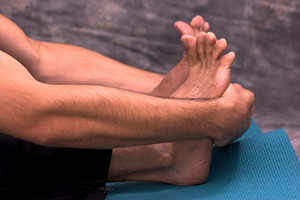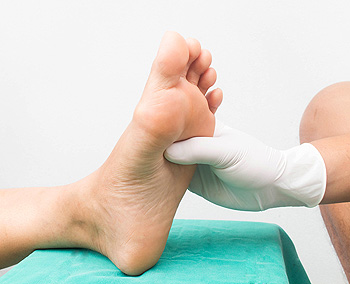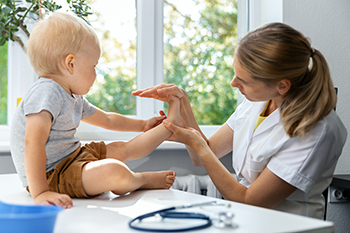Items filtered by date: August 2022
Tendonitis in the Foot and Ankle

Tendons are thick bands of tissue that connect muscles to bones. The feet and ankles have a large number of tendons, any of which can become inflamed, a condition known as tendonitis. The main cause of tendonitis is overuse from repetitive movement. For that reason tendonitis is especially common to runners, because if a tendon is made to work too hard or too long it can develop tears. Other causes of foot and ankle tendonitis include an abnormal foot structure like flat feet or high arches, an injury, or a medical condition, such as gout or rheumatoid arthritis. The primary symptom of tendonitis in the foot or ankle is sharp, burning pain, often followed by swelling and stiffness. In many cases, tendonitis can be treated successfully, though the recovery period may take weeks, or even months. The first way to begin the process is to rest the painful area and cease the activity that caused it. If pain continues, or worsens, it is a good idea to visit a podiatrist for a thorough exam. The doctor may prescribe a variety of treatment options to ease the inflammation, including medication, orthotics, and exercises.
Foot and ankle trauma is common among athletes and the elderly. If you have concerns that you may have experienced trauma to the foot and ankle, consult with the foot specialists from Podiatry Associates of Belleville. Our doctors will assess your condition and provide you with quality foot and ankle treatment.
Foot and ankle trauma cover a range of injuries all over the foot; common injuries include:
- Broken bones
- Muscle strains
- Injuries to the tendons and ligaments
- Stress fractures
Symptoms
Symptoms of foot and ankle injuries vary depending on the injury, but more common ones include:
- Bruising
- Inflammation/ Swelling
- Pain
Diagnosis
To properly diagnose the exact type of injury, podiatrists will conduct a number of different tests. Some of these include sensation and visual tests, X-rays, and MRIs. Medical and family histories will also be taken into account.
Treatment
Once the injury has been diagnosed, the podiatrist can than offer the best treatment options for you. In less severe cases, rest and keeping pressure off the foot may be all that’s necessary. Orthotics, such as a specially made shoes, or immobilization devices, like splints or casts, may be deemed necessary. Finally, if the injury is severe enough, surgery may be necessary.
If you have any questions, please feel free to contact our office located in Belleville, NJ . We offer the newest diagnostic and treatment technologies for all your foot care needs.
Stretching the Toes

The benefits of stretching one’s feet are plentiful as are the toes. Someone serious about protecting the overall health of their feet can perform several different toe stretches to not only increase the strength of their toes but to improve mobility and agility. These benefits can be particularly helpful for individuals who are prone to falling. The first toe stretch that you might consider performing as part of a regular foot stretching routine is known as the big toe pull. You can perform this stretch by getting in a seated position and wrapping a belt or towel around the big toe. Extend the lower leg off the ground and pull the belt towards you as you repeatedly push the big toe against the belt. The big toe should be working against your pulling motion of the belt. This should be performed on one foot at a time. You might also choose to perform the doming stretch. This involves sitting on the ground while your feet are flat on the floor in front of you. You then will try to grab the floor with your toes, being sure that you are not simply curling the toes inward. You can then hold this position for five seconds or so. Stretching the toes is undoubtedly important, just as it is to remember to listen to your body throughout the exercises and to stretch gently. If you want to learn more about the benefits of stretching your feet, contact a podiatrist.
Stretching the feet is a great way to prevent injuries. If you have any concerns with your feet consult with the foot specialists from Podiatry Associates of Belleville. Our doctors will assess your condition and provide you with quality foot and ankle treatment.
Stretching the Feet
Being the backbone of the body, the feet carry your entire weight and can easily become overexerted, causing cramps and pain. As with any body part, stretching your feet can serve many benefits. From increasing flexibility to even providing some pain relief, be sure to give your feet a stretch from time to time. This is especially important for athletes or anyone performing aerobic exercises, but anyone experiencing foot pain or is on their feet constantly should also engage in this practice.
Great ways to stretch your feet:
- Crossing one leg over the others and carefully pull your toes back. Do 10-20 repetitions and repeat the process for each foot
- Face a wall with your arms out and hands flat against the wall. Step back with one foot and keep it flat on the floor while moving the other leg forward. Lean towards the wall until you feel a stretch. Hold for 30 seconds and perform 10 repetitions for each foot
- Be sure not to overextend or push your limbs too hard or you could risk pulling or straining your muscle
Individuals who tend to their feet by regular stretching every day should be able to minimize foot pain and prevent new problems from arising.
If you have any questions, please feel free to contact our office located in Belleville, NJ . We offer the newest diagnostic and treatment technologies for all your foot care needs.
Three Tips for Preventing Falls

As an individual gets older and older, their risk of suffering a dangerous trip or fall increases. Many things can make seniors more likely to trip. For example, having poor eyesight and taking medication that makes one feel dizzy as a side effect can increase their likelihood of falling. However, many factors are related to the feet that can also make falling likely. For example, ill-fitting footwear that is either too loose, bulky, or slippery can be dangerous. Instead of wearing this kind of footwear, it is recommended that seniors try to use shoes with non-slip soles. This will enable the senior to get a better grip on the ground, making tripping less probable. Additionally, to prevent falls at the very beginning of the day, a senior might consider ensuring that their feet can easily touch the floor from a seated position on their bed. When a senior takes their first steps of the day, they must do everything they can to increase their stability. Having their feet comfortably reach the floor from their bed is a great start. They might even try sitting in an upright position for a few minutes before putting their weight on their feet at the beginning of the day to stimulate blood flow. All of this makes falling less likely when taking the first steps of the day. If you are a senior looking to prevent a dangerous fall, contact a podiatrist.
Preventing falls among the elderly is very important. If you are older and have fallen or fear that you are prone to falling, consult with the foot specialists from Podiatry Associates of Belleville. Our doctors will assess your condition and provide you with quality advice and care.
Every 11 seconds, an elderly American is being treated in an emergency room for a fall related injury. Falls are the leading cause of head and hip injuries for those 65 and older. Due to decreases in strength, balance, senses, and lack of awareness, elderly persons are very susceptible to falling. Thankfully, there are a number of things older persons can do to prevent falls.
How to Prevent Falls
Some effective methods that older persons can do to prevent falls include:
- Enrolling in strength and balance exercise program to increase balance and strength
- Periodically having your sight and hearing checked
- Discuss any medications you have with a doctor to see if it increases the risk of falling
- Clearing the house of falling hazards and installing devices like grab bars and railings
- Utilizing a walker or cane
- Wearing shoes that provide good support and cushioning
- Talking to family members about falling and increasing awareness
Falling can be a traumatic and embarrassing experience for elderly persons; this can make them less willing to leave the house, and less willing to talk to someone about their fears of falling. Doing such things, however, will increase the likelihood of tripping or losing one’s balance. Knowing the causes of falling and how to prevent them is the best way to mitigate the risk of serious injury.
If you have any questions, please feel free to contact our office located in Belleville, NJ . We offer the newest diagnostic and treatment technologies for all your foot care needs.
Peripheral Neuropathy and the Feet

Peripheral neuropathy is a condition that primarily affects the nerves of the body by making you feel abnormal sensations or fail to feel sensations that you should be feeling. This condition can affect nerves throughout the body, but it can also affect the feet, which can be particularly uncomfortable. The nerve damage in the feet can make you feel a variety of symptoms. These symptoms might include a feeling of numbness in the feet, a “pins and needles” feeling, periodic shooting pains, and difficulty balancing on your feet, among many other things. Importantly, if you have neuropathy in your feet, it can be a good idea to take extra precautions for your feet. For example, check them regularly to ensure that they have not gotten an injury that you did not notice or feel. Also, you might consider being extra diligent about keeping them warm and well-covered during colder winter months, as neuropathy can interfere with the feet’s sensitivity to cold weather. If you or a loved one suffer from neuropathy in the feet, contact a podiatrist.
Neuropathy
Neuropathy can be a potentially serious condition, especially if it is left undiagnosed. If you have any concerns that you may be experiencing nerve loss in your feet, consult with the foot specialists from Podiatry Associates of Belleville. Our doctors will assess your condition and provide you with quality foot and ankle treatment for neuropathy.
What Is Neuropathy?
Neuropathy is a condition that leads to damage to the nerves in the body. Peripheral neuropathy, or neuropathy that affects your peripheral nervous system, usually occurs in the feet. Neuropathy can be triggered by a number of different causes. Such causes include diabetes, infections, cancers, disorders, and toxic substances.
Symptoms of Neuropathy Include:
- Numbness
- Sensation loss
- Prickling and tingling sensations
- Throbbing, freezing, burning pains
- Muscle weakness
Those with diabetes are at serious risk due to being unable to feel an ulcer on their feet. Diabetics usually also suffer from poor blood circulation. This can lead to the wound not healing, infections occurring, and the limb may have to be amputated.
Treatment
To treat neuropathy in the foot, podiatrists will first diagnose the cause of the neuropathy. Figuring out the underlying cause of the neuropathy will allow the podiatrist to prescribe the best treatment, whether it be caused by diabetes, toxic substance exposure, infection, etc. If the nerve has not died, then it’s possible that sensation may be able to return to the foot.
Pain medication may be issued for pain. Electrical nerve stimulation can be used to stimulate nerves. If the neuropathy is caused from pressure on the nerves, then surgery may be necessary.
If you have any questions, please feel free to contact our office located in Belleville, NJ . We offer the newest diagnostic and treatment technologies for all your foot care needs.
Are Bunions Affecting Your Everyday Life?
Choosing Baby's 1st Pair of Shoes After Walking

Most babies do not wear shoes until they begin to walk comfortably. As the toes grip the floor, the bones, tendons, muscles and ligaments in each foot can become stronger. It is important that the toes have enough room in the socks to move freely, and are not stretched too tight over the foot. Many people choose to have their child’s feet properly measured when purchasing their child's first pair of shoes. This is done by measuring the length and the width of each foot, which can help to determine the exact size shoe your child should wear. Shoes that fit properly have adequate room for the toes, and the heel should fit securely. If your child’s foot slips out of the shoe while walking, the next size smaller may be considered. Children’s feet grow fast, and it is beneficial to have them measured every four to six weeks. The rate the feet grow will slow down at approximately four years of age, and then generally increase one size per year until age twenty. If you would like additional information about what to look for before purchasing your child’s shoes, please confer with a podiatrist.
The health of a child’s feet is vital to their overall well-being. If you have any questions regarding foot health, contact the foot specialists of Podiatry Associates of Belleville. Our doctors can provide the care you need to keep you pain-free and on your feet.
Tips for Keeping Children's Feet Healthy
- Make sure their shoes fit properly
- Look for any signs of in-toeing or out-toeing
- Check to see if they have Clubfoot (condition that affects your child’s foot and ankle, twisting the heel and toes inward) which is one of the most common nonmajor birth defects.
- Lightly cover your baby’s feet (Tight covers may keep your baby from moving their feet freely, and could prevent normal development)
- Allow your toddler to go shoeless (Shoes can be restricting for a young child’s foot)
- Cut toenails straight across to avoid ingrown toenails
- Keep your child’s foot clean and dry
- Cover cuts and scrapes. Wash any scratches with soap and water and cover them with a bandage until they’ve healed.
If you have any questions, please feel free to contact our office located in Belleville, NJ . We offer the newest diagnostic and treatment technologies for all your foot care needs.
